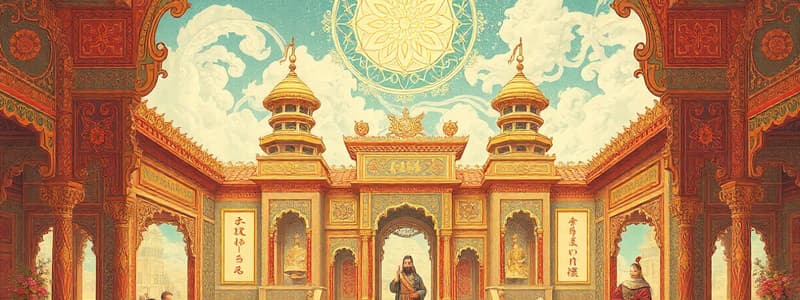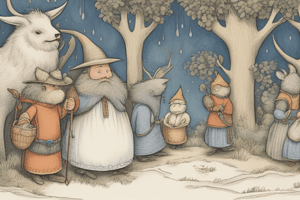Podcast
Questions and Answers
What advantage did the Great Jin have over the Mongols during their initial encounters?
What advantage did the Great Jin have over the Mongols during their initial encounters?
- Larger population and a professional army (correct)
- Greater knowledge of the terrain
- Superior agricultural practices
- Advanced naval technology
How did the Mongols manage to conduct their invasions effectively during winter?
How did the Mongols manage to conduct their invasions effectively during winter?
- They constructed ice roads for their cavalry
- They built temporary shelters
- They had the ability to gather food in cold conditions (correct)
- They used sledges for transportation
What was one major flaw in the Chinese army's strategy when facing the Mongols?
What was one major flaw in the Chinese army's strategy when facing the Mongols?
- Absence of horse archers (correct)
- Lack of experienced leadership
- Ineffective use of heavy infantry
- Overreliance on cavalry
What was the primary tactic used by Chingis Khan to avoid direct conflict with the Chinese armies?
What was the primary tactic used by Chingis Khan to avoid direct conflict with the Chinese armies?
What was a key requirement for defeating the Mongols that most armies were unable to achieve?
What was a key requirement for defeating the Mongols that most armies were unable to achieve?
What significant change did Kublai Khan make regarding his leadership after losing most of his empire?
What significant change did Kublai Khan make regarding his leadership after losing most of his empire?
Which war justification tactic did the Mongols commonly employ before launching an invasion?
Which war justification tactic did the Mongols commonly employ before launching an invasion?
What significant event led to the Mongols retreating from Europe?
What significant event led to the Mongols retreating from Europe?
Which of the following territories did Kublai Khan invade as part of his campaign after settling in China?
Which of the following territories did Kublai Khan invade as part of his campaign after settling in China?
What geographical features made Western Europe less appealing to the Mongols for conquest?
What geographical features made Western Europe less appealing to the Mongols for conquest?
What was the main idiosyncrasy of the Mongol Ulus that set it apart from the other khanates?
What was the main idiosyncrasy of the Mongol Ulus that set it apart from the other khanates?
What internal conflict impacted the ability of the Golden Horde to invade Europe?
What internal conflict impacted the ability of the Golden Horde to invade Europe?
How did the Mongols generally view conquered tribes within their empire?
How did the Mongols generally view conquered tribes within their empire?
What role did Russian alliances play in the power dynamics of the Golden Horde?
What role did Russian alliances play in the power dynamics of the Golden Horde?
What impact did Kublai Khan's rule have on Chinese dynasties?
What impact did Kublai Khan's rule have on Chinese dynasties?
After the Mongols stopped attempting to invade Western Europe, what did they focus on instead?
After the Mongols stopped attempting to invade Western Europe, what did they focus on instead?
What was one of the major consequences of the Mongol invasions on their targets?
What was one of the major consequences of the Mongol invasions on their targets?
How did the Russian rulers enhance their power while under Mongol rule?
How did the Russian rulers enhance their power while under Mongol rule?
What strategy did Kublai Khan utilize in his letter to Japan to justify potential invasion?
What strategy did Kublai Khan utilize in his letter to Japan to justify potential invasion?
What was one of the main reasons the Golden Horde could not expand significantly beyond Poland and Hungary?
What was one of the main reasons the Golden Horde could not expand significantly beyond Poland and Hungary?
What resulted from the civil wars within the Golden Horde?
What resulted from the civil wars within the Golden Horde?
Flashcards
Mongol Empire Split
Mongol Empire Split
The Mongol Empire divided into four separate empires in 1266: Golden Horde, Chagatai, Ilkhanate, and Mongol Ulus.
Yuan Dynasty
Yuan Dynasty
The Mongol Empire in East Asia, renamed by Kublai Khan in China in 1267.
Kublai Khan's Focus
Kublai Khan's Focus
Kublai Khan concentrated on conquering China after losing much of the Mongol Empire.
Chinese Wealth
Chinese Wealth
Signup and view all the flashcards
Mongol Justification for War
Mongol Justification for War
Signup and view all the flashcards
Japanese Tribute
Japanese Tribute
Signup and view all the flashcards
Mongol Ulus
Mongol Ulus
Signup and view all the flashcards
Kublai Khan's Letter to Japan
Kublai Khan's Letter to Japan
Signup and view all the flashcards
Mongol Winter Strategy
Mongol Winter Strategy
Signup and view all the flashcards
Mongol Horse Archers
Mongol Horse Archers
Signup and view all the flashcards
Chinese Military Weakness
Chinese Military Weakness
Signup and view all the flashcards
Great Jin and Mongols
Great Jin and Mongols
Signup and view all the flashcards
Mongol Conquest Strategy
Mongol Conquest Strategy
Signup and view all the flashcards
Mongol Retreat
Mongol Retreat
Signup and view all the flashcards
Western Europe's Geography
Western Europe's Geography
Signup and view all the flashcards
Khanate Wars
Khanate Wars
Signup and view all the flashcards
Golden Horde Focus
Golden Horde Focus
Signup and view all the flashcards
Russian Alliances
Russian Alliances
Signup and view all the flashcards
Russian Power Growth
Russian Power Growth
Signup and view all the flashcards
Civil Wars in the Horde
Civil Wars in the Horde
Signup and view all the flashcards
Mongol Tribute
Mongol Tribute
Signup and view all the flashcards
Study Notes
The Mongol Empire
- The Mongols were responsible for spreading Islam across Asia, bringing gunpowder to Europe, creating the Mughal Empire in India, and influencing the meaning of the word "kamikaze".
- Mongols constantly fought over territory, comprised of various clans, each claiming descent from legendary warriors.
- Temüjin, later known as Genghis Khan, was born in 1162. His father was killed when Temüjin was 9 years old, leading to his clan being overtaken by another.
- Genghis Khan formed an alliance with another clan to gather an army, and attained considerable strength by the age 40.
- By 1204, Genghis Khan conquered rival clans, who became his allies, and their warriors became part of his army.
- Genghis Khan established a system where individuals attained positions based on merit and performance, rather than family ties.
- This merit-based system fostered loyalty and competence within the Mongol administration.
- In 1206, at the age of 44, Temüjin was crowned Genghis Khan, the Great Khan of all Mongols, launching the Mongol Empire.
- Key goals of the Mongol Empire included ensuring only the Khan's family could rule and the expansion of their borders by conquering neighboring territory.
Mongol Empire's Expansion
- The Mongols conquered many groups, including the Turks, Tatars, and the Khwarazmian Empire over multiple years, expanding their empire.
- Mongols used assimilation to integrate new territories and conquered people into their culture: conquered people were forced to adopt Mongol customs and traditions.
- The Mongols were initially nomadic, organized into groups called hordes, which were self-sufficient.
- Mongols adapted technologies from conquered groups, like catapults and missile technology from China.
- The Mongols implemented military strategies like winter invasions (using knowledge of harsh Siberian winters).
- Mongol success largely came from adaptability, efficiency, and the strength of their military forces.
- Mongols frequently used a system of conquered peoples ruling their own territories and paying tribute.
Mongol Empire's Structure
- Conquered territories were usually not directly ruled by Mongols, but administered by local officials who were part of the Mongol Bureaucracy.
- The Mongol Empire was organized into distinct regions, called Khanates, ruled by members of Genghis Khan's family, ultimately reporting to a Great Khan.
- The Khanates included the Golden Horde (in Eurasia), the Chagatai Khanate (in Central Asia), and the Ilkhanate (in Persia).
- Tribute and plunder were significant parts of Mongol economics and administration, with resources often shared among the Khanates and their people.
Decline of the Empire
- The Mongol empire began to fragment and fall apart after around 1200 years.
- Civil wars and internal conflicts within the Mongol Empire contributed significantly to the disintegration of the empire.
- Various factors, including widespread natural disasters, challenged Mongol rule, contributing to its weakening.
- The Black Death plague further weakened the empire in various sections.
Studying That Suits You
Use AI to generate personalized quizzes and flashcards to suit your learning preferences.




